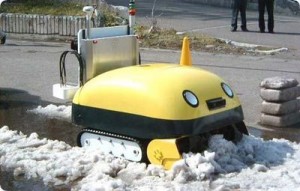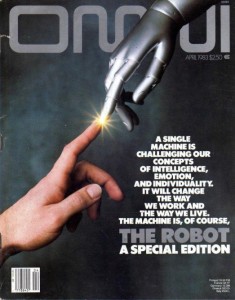
In science fiction, robots perform all kinds of tasks. Sometimes they dictate the fate of humanity, such as in Isaac Asimov’s “Reason,” in which Q-T, a robot with impressive and frustrating existential curiosity, keeps an energy beam steady during an electron storm, thus saving everyone relying on that energy. In Asimov’s “Runaround,” a robot named Speedy is sent on a dangerous mission to gather selenium on Mercury. These two stories exemplify the three Ds of modern robotics—making robots to perform tasks that are dull, dirty, and/or dangerous.
It makes sense that robot development would head in this direction—even Rosie of the Jetsons regularly attended to two of the three Ds. Now we have “family” robots such as Jibo to help us realize the domestic dreams fueled by Rosie, and robots such as Rapiro and Nextage that can make us our daily cup of joe (though the speed of the preparation and the quality of the coffee might be up for debate). Then again, making a cup of coffee isn’t particularly dull, dirty, or dangerous. But I’ll tell you what is—shoveling snow.
After digging out of this week’s snowpocalypse, I can say with confidence that I’m over shoveling. It was fun for the first ten minutes or so, bearable for the next hour, and then it got pretty old, especially as my fingers and toes started freezing while other parts of me started overheating. Omni Magazine, a groundbreaker in the then genre of science writing back in 1978 when it debuted, predicted that “by 2010, robots would “clean the rug, iron the clothes, and shovel the snow.” Omni, Asimov, and so many other sci-fi writers were right.

Check out Yuki-taro, a robot that looks like Pikachu made babies with a tank (“yuki” means snow in Japanese, and “Taro” is a common Japanese name for a boy). The thing eats snow—even dirty, salty, slushy, snow, and then it poops out snow bricks, like of like those plastic igloo-making snow toys, except way better because—well, because it’s a robot. Duh. Yuki-taro “the friendly snowbot” comes equipped with two omni-directional VGA cameras, twin servomotors, a GPS positioning sensor, laser and ultrasonic range sensors, and obstacle recognition software, all of which enable it to guide itself to snowy streets. It spent its early days practicing its snow removal in Niigata, Japan, which receives an average of 85 inches of snowfall per year. Its developers first debuted the machine back in 2005 with the promise of bringing a version to market at an estimated cost of roughly $9,000. They said it would only take five years or so, and now it’s been ten. Sadly, it seems that even after winning the Good Design Award, Yuki-taro has gotten stuck in its tracks. I’d like to make an official plea now to bring it back—and to bring it to Boston.
While $9,000 might seem a bit extravagant to get out of shoveling duty, I can’t help thinking how handy it would be to have a couple of these around Boston right now (especially given the $18.5 million snow removal budget, which will likely be exceeded).

One of the biggest challenges associated with a large snowstorm is what to do with all the snow. The city is so dense that there’s really nowhere to put it all—there are snowbanks twice my height, at least half of the usual parking spots are nonexistent, and roads in some areas are still dodgy. Once upon a time, dump trucks used to toss snow into the Charles River, which may explain, in part, how the water got so polluted. I love this retrospective on Boston snow removal over the past couple centuries, particularly the SNOWTRON snow melter used in the 60s (and which cost the equivalent of $750,000). Maybe the ultimate problem with SNOWTRON is that it wasn’t a robot, even though its name suggests that it should be.

Yuki-taro’s snow removal system is ingenious. It doesn’t push or blow snow to the side or into massive drifts—it essentially eats the snow through its shovel-like mouth, uses an internal compressor to “digest” them, and then poops out small, stackable snow bricks. Sure, one would have to find something to do with the poop-bricks, but kids could play with them, they could be stored for later use, or fashioned into some kind of awesome snow house—perhaps a garage to house the machine, because even snowbots deserve a little shelter from the storm.
